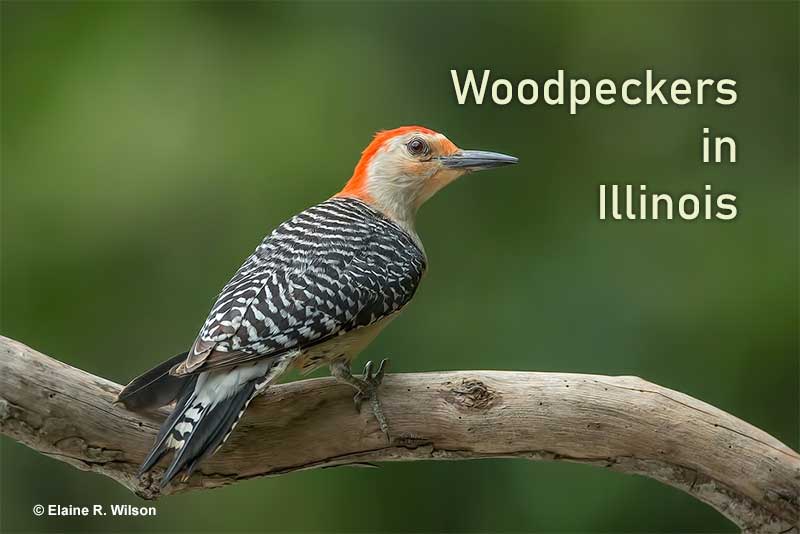
Do woodpeckers live in Illinois? Yes, woodpeckers occur throughout Illinois!
Watch birds anywhere in Illinois, and you’ll see woodpeckers. Northern Flickers and Red-bellied Woodpeckers call from parks and Downy Woodpeckers visit backyard feeders.
A dozen woodpecker species have been seen in Illinois and seven of those are common birds.
How many woodpeckers in Illinois have you seen? Were you able to identify all of them?
This list of the common woodpeckers of Illinois will help!
Woodpeckers in Illinois
Based on eBird data, our list shows the seven most common woodpecker species in Illinois.
To help identify these beautiful birds and know where to see them, we have also included information about their field marks and behavior.
Red-bellied Woodpecker
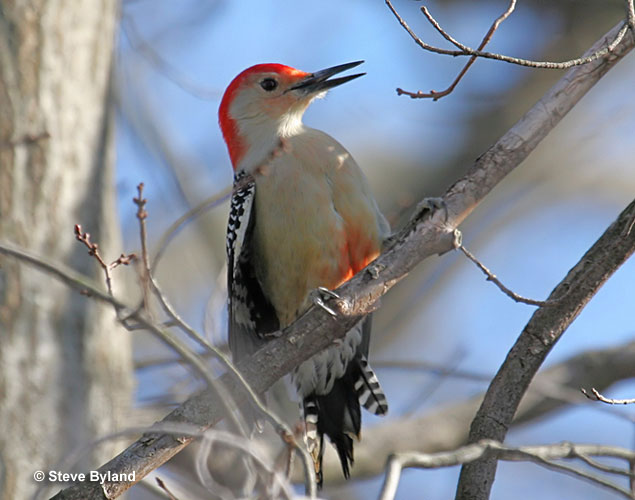
Scientific name: Melanerpes carolinus
Length: 9.25 inches
Wingspan: 16 inches
Red-bellied Woodpeckers are bold birds with a long, dark, chisel-like beak, and backs with zebra-like barring. They also have black and white bars on their long, closed wings, and a bold white rump with some black speckling.
Despite their name, it’s really hard to see the red on this bird’s underparts! Although they do have a bit of red or reddish-orange, it’s hidden on the lower part of their belly.
The rest of their underparts and face are a pale gray-buff color, and they have a bit of orange above their beak.
Male Red-bellied Woodpeckers have bright red on their crown and nape. Females only have red on their nape and young birds only show a bit of orange on the back of their head.
We see pairs of this common woodpecker species in all sorts of woodlands. As long as big trees are present, they can even live in urban areas and often come to feeders.
Key identifications:
- In most of their range, Red-bellied Woodpeckers are the only woodpecker species that has zebra-like, black and white barring on their back and wings.
- Red-bellied Woodpeckers have a pale face and red on their nape.
- This species has plain buff-gray underparts.
Downy Woodpecker

Scientific name: Dryobates pubescens
Length: 6.75 inches
Wingspan: 12 inches
Downy Woodpeckers are small, cute woodpeckers with black and white plumage. They have bold, black and white markings on their heads, black and white wings, and white underparts.
They also have a white back, black rump, and black and white tail. This woodpecker is slightly bigger than a sparrow, and has white, tufted feathers above its short beak.
Male Downy Woodpeckers have a small red patch on the back part of their head. Females look like males but lack this red patch, and young birds have red on the top of their heads.
They are common in all sorts of wooded habitats. Downy Woodpeckers like to use their small beaks to peck into twigs and often forage with flocks of chickadees and other birds.
This beautiful little woodpecker is also a regular visitor to backyards and can live in urban areas with lots of trees. They also come to bird feeders, especially ones that offer suet and peanuts.
Key identifications:
- Downy Woodpeckers are smaller than all other woodpeckers in North America. They are nearly as small as a House Sparrow.
- This species has a short and stubby beak (for a woodpecker).
- Downy Woodpeckers have small dark markings on their white outer tail feathers.
Northern Flicker
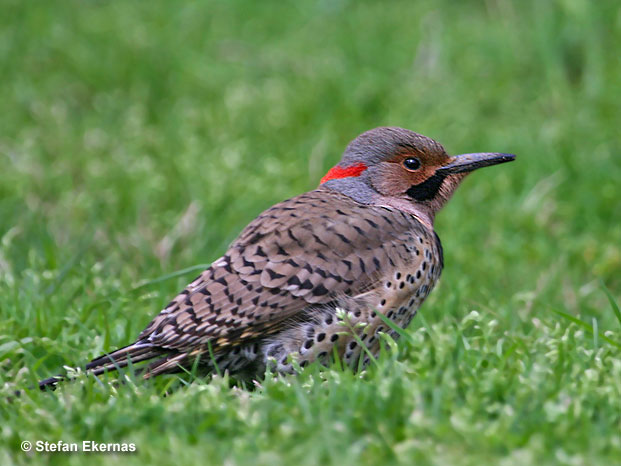
Scientific name: Colaptes auratus
Length: 12.5 inches
Wingspan: 20 inches
Northern Flickers are big, unique, gray and tan woodpeckers with bold white rumps. They have buff underparts with black spotting and a bold black patch on their chest, and fine black barring on their back and wings.
This species has some differences depending on where they live. Eastern species are called Yellow-shafted Flickers. They have a small red spot on their nape, and a black mustache mark (males). Eastern birds also have bright yellow underwings.
In the meanwhile, western species are known as Red-shafted Flickers. They are known to have grayer heads, and males have a red mustache. They also have reddish on their underwings.
Northern Flickers love parks, golf courses, and other semi-open habitats. In such places, we often see them in bounding flight, or perched on the ground as they forage for ants. These noisy birds also make laughing calls and “wicka-wicka” vocalizations.
Since this species eats ants, it rarely, if ever, comes to bird feeders.
Key identifications:
- In most of their range, Northern Flickers are the only woodpecker with gray and brown plumage.
- This species has a gray crown and fine black barring on its tan-colored back.
- Northern Flickers also have a black chest patch and black spotting on their underparts.
Hairy Woodpecker
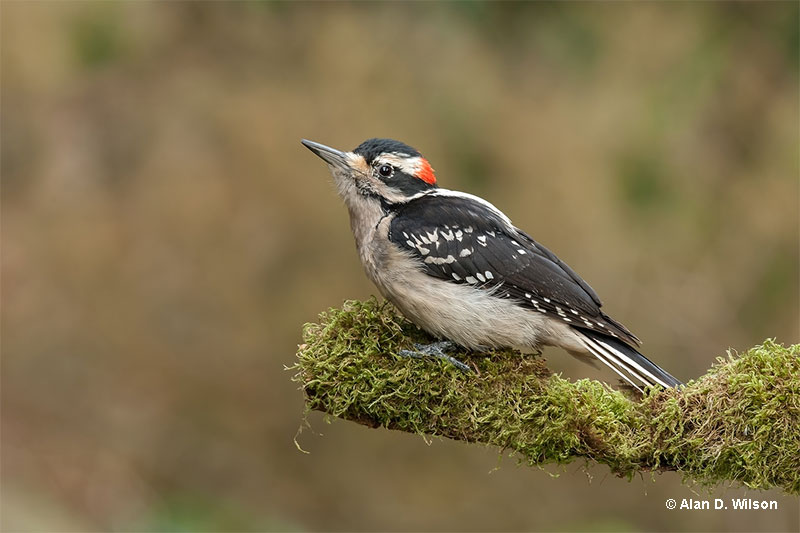
Scientific name: Dryobates villosus
Length: 9.25 inches
Wingspan: 15 inches
Hairy Woodpeckers are medium-sized, black and white woodpeckers with a fairly long and sharp beak. They have a bold black and white pattern on their head, white back, black rump, and black and white wings.
Hairy Woodpeckers also have white underparts and a pale front. Males have a small red patch on the back of their head, females lack this patch, and juveniles have a red patch on top of their head.
They look incredibly similar to Downy Woodpecers, but Downys like second-growth and plants with thin stems, Hairy Woodpeckers only live in places with big, mature trees. We mostly find these woodpeckers in forests, but they can also occur in parks and suburban areas that have lots of big trees. They also come to enjoy some suet in backyard feeders during winter months.
Key identifications:
- Hairy Woodpeckers have noticeably longer beaks than Downy Woodpeckers, and are also larger birds.
- The Hairy Woodpecker has a big white patch on its back.
- This species has plain white underparts and clean white outer tail feathers.
Red-headed Woodpecker

Scientific name: Melanerpes erythrocephalus
Length: 9.25 inches
Wingspan: 17 inches
Red-headed Woodpeckers are beautiful, medium-sized woodpeckers with a completely deep red head. Adults of both sexes look alike and have a sharp gray bill, and bright white underparts.
Their upperparts are glossy black with a snow-white rump, and big white patches on their wings. Juvenile Red-headed Woodpeckers have a similar plumage pattern but have a gray-brown head, and some dark markings on their wings and underparts.
This striking bird prefers semi-open habitats with mature oaks, snags, and other big trees. We see them on golf courses, at the edges of rivers and other wetlands, and other places with similar-looking habitat.
In some places, this beautiful bird also occurs in urban areas, especially in the southeastern USA.
Red-headed Woodpeckers like to peck into trees like other woodpeckers but they also catch insects in flight. With that in mind, we often see them sallying into the air from tall snags next to open areas.
Key identifications:
- Red-headed Woodpeckers are the only woodpecker species in eastern North America with an entirely red head.
- This species has a unique wing pattern with big white patches on the base of each wing.
- The Red-headed Woodpecker has a black tail and an extensive white rump.
Pileated Woodpecker
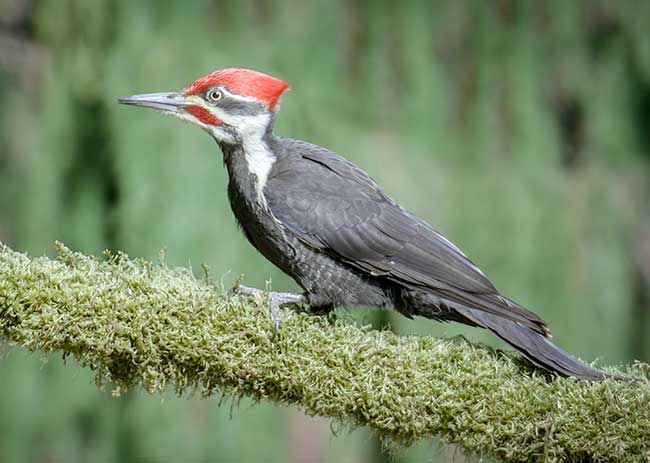
Scientific name: Dryocopus pileatus
Length: 16.5 inches
Wingspan: 29 inches
Pileated Woodpeckers are really big woodpeckers. If the Ivory-billed Woodpecker is actually extinct, that would make Pileated Woodpeckers the biggest woodpecker species in North America.
These unmistakable woodpeckers are mostly black with a thick white line on each side of their neck, and a white throat.
They also have a red crest and a long, grayish beak. Males have a small red mustache, while females have a black line that extends from their beaks to their necks.
Pileated Woodpeckers also have a small white patch on the upper part of each wing. It’s easier to see this mark and the white underwings when the big woodpecker takes flight.
This fantastic woodpecker lives in forests and woodlands with lots of big, mature trees. For that reason, we don’t usually see them in urban areas. However, they can visit feeders at houses next to or within forest!
Key identifications:
- In most places, Pileated Woodpeckers are the only big black and white woodpecker with a red crest.
- This species has a small white patch near the tip of each upperwing. They also have white wing linings.
- Pileated Woodpeckers have a lot of white on their face and a completely black back.
Yellow-bellied Sapsucker
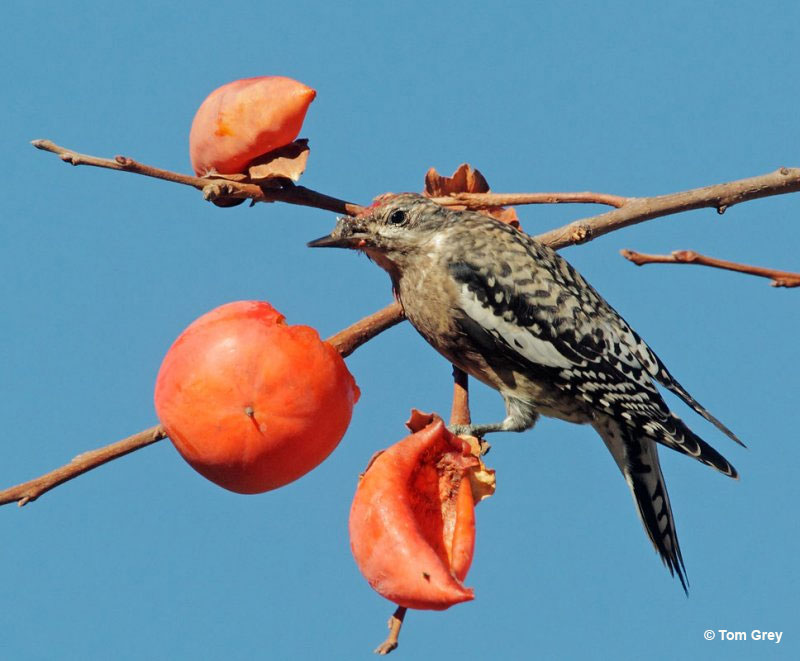
Scientific name: Sphyrapicus varius
Length: 8.5 inches
Wingspan: 16 inches
Yellow-bellied Sapsuckers are pretty, medium-sized woodpeckers with white shoulders. They have a black and white face, black chest, and uneven black and white barring on their backs.
This woodpecker species has pale yellow on its underparts, small black markings on its sides, and a red patch on its head.
Males also have a red throat bordered with black, while females have a white throat. Juvenile Yellow-bellied Sapsuckers look like adults but are more dingy gray-brown, and lack red on their heads.
This migratory species likes to peck rows of small holes in deciduous trees. It drinks the sap that comes out as well as insects attracted to the sap.
Yellow-bellied Sapsuckers breed in northern and montane forests, so they are not usually seen in Illinois during breeding season. They are much more common during migration, and some may stay for winter, which they spend in parks and a variety of woodland habitats.
Key identifications:
- Yellow-bellied Sapsuckers are the only woodpeckers in most of their range with white shoulders.
- This species has a black chest and uneven barring on its sides.
- The Yellow-bellied Sapsucker has lots of uneven, mottled black and white barring on its back.
Frequently Asked Questions
Are woodpeckers common in Illinois?
Yes, woodpeckers are common in Illinois. At least 7 species are common birds throughout the state.
What is the largest woodpecker in Illinois?
The largest woodpecker in Illinois is the Pileated Woodpecker. This species is 16.5 inches long!
Do Illinois woodpeckers migrate?
No, most Illinois woodpeckers do not migrate. However, one regularly occurring species, the Yellow-bellied Sapsucker, does migrate south for the winter.
Does Chicago have woodpeckers?
Yes, Chicago has woodpeckers. Several species occur in the Windy City.
Read next – Common bird species in Illinois | Owls in Illinois

